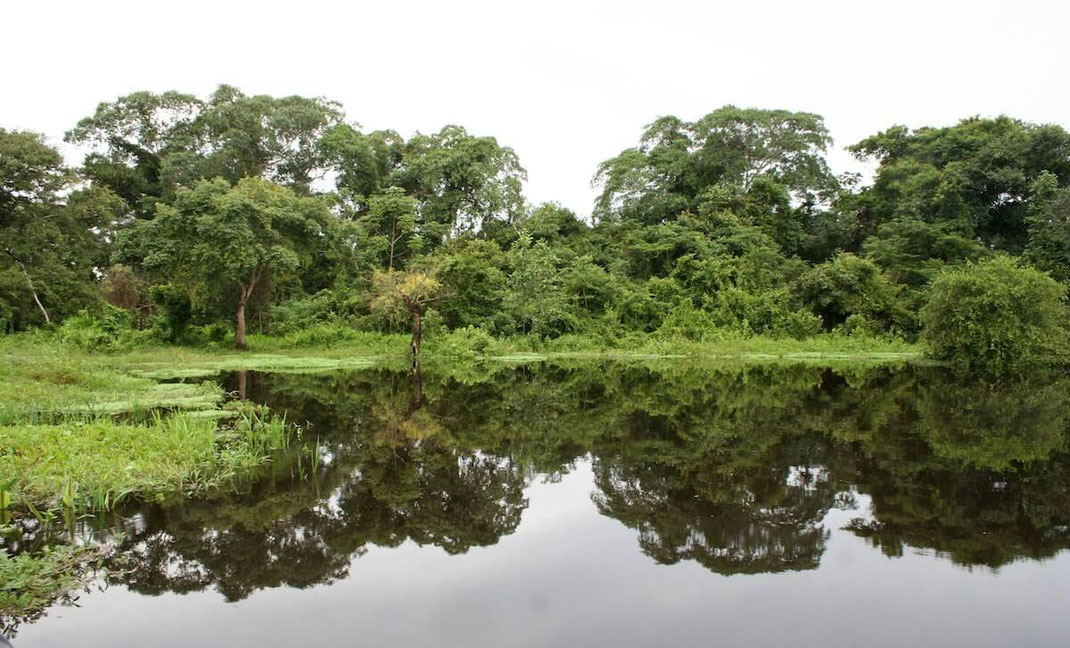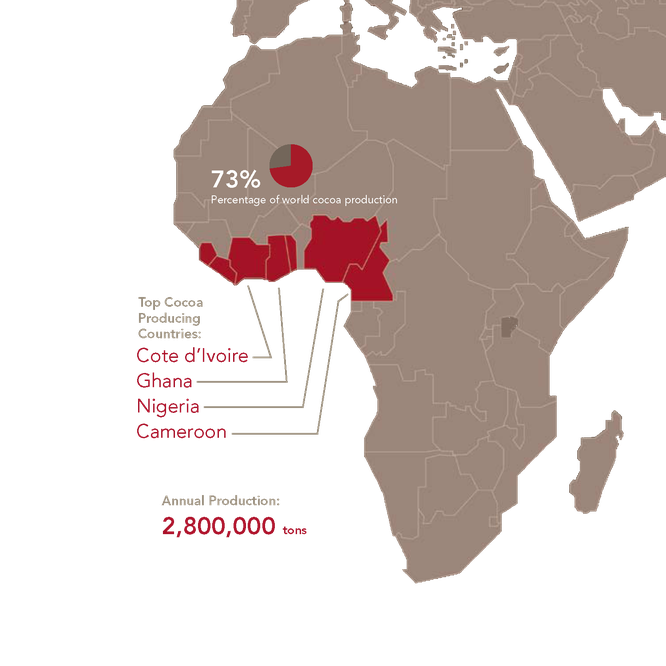THE GLOBAL MARKET
Where does Cacao grow and who are the farmers, the gardeners of the Cacao plant? What journey does Cacao undertake, from the flower to the wonderful rich drink enjoyed in ceremony? Read about the global flow of Cacao, and how the future looks for our beloved plant on an economical and agricultural level.

WHERE DOES CACAO GROW?
Originally the cacao plant comes from Central and South America. However, it can be found spread along the whole equatorial belt. It grows within about 20 degrees of latitude north and south of the equator. This is called the '20/20zone'. The main growing area of cacao, especially for large-scale chocolate production, is now Western Africa.
Historically, the shift of the main growing area from the Americas to West Africa coincides with the abolition of slavery. Since the slaves could no longer be brought from Africa to America, the cacao was brought to the areas of their homeland, to continue the production of cheap cacao for Europe under forced labour conditions.
THE 20/20 ZONE
Cacao grows 20 degrees north and south of the equator. This is called the 20/20 zone.

CACAO LOVES COMMUNITY · THE PROBLEM WITH MONO-CULTURES
Cacao needs very fertile and clean soils and grows best in community. Direct sunlight damages the plant and can lead to a number of diseases. Cultivating cacao plants in mono-culture is therefore problematic both for the plant itself, which requires the sun protection of larger trees such as coconut palms or banana trees, and for the soils which are rapidly leached by it.
Due to its high content of cadmium, the cacao plant not only absorbs flavours from the environment, but also poisons contained in soils. The perfect surroundings for cacao plants are that of permaculture, embedded in the natural structures of tropical forests. However, such cultivation makes it difficult to meet the high global demand for cacao.
THE DARK SIDE OF CHOCOLATE

As much as we like to work with Cacao, the beautiful spirit and teacher, it is equally important to be aware of what is going on in the world; to bring to light the truth that is hiding in the dark. The majority of the cacao on our planet is harvested for the industrial production of chocolate and other related products.
Cacao is facing enormous global challenges forming a complex development issue touching the social, economic and environmental level. Many districts in Ghana and the Ivory Coast started to devote themselves to growing Cacao. This is profitable for governments and international traders leaving the farmers at a subsistence level. Low wages force the farmers to employ children as labourers for the harvest as they can't afford external staff. This leads to the worst effects of child labour. Children are kidnapped and subjected to plantations against their will. As slaves they are exposed to long hours of physical work, a lack of education & the unprotected use of chemicals & pesticides.
Cheap prices in the cocoa industry give small farmers with very low income no choice but to withdraw their children from school and send them to the plantations. With poor access to education and frequent absences in schools, the families are caught in a vicious cycle of poverty. The cocoa producers have little bargaining power against the few large multinational companies that control the supply chain and ultimately determine the existence of the peasant families. Heavy metals such as cadmium, lead and aluminium will be a major concern not only for the industry in the production of chocolate in the future, but for the local people who are dependent on agriculture.
DOCUMENTARIES, INITIATIVES & RESOURCES
If you'd like to know more about the inequality that is perpetuated in the asymmetrical relationship between cacao farmers of the south (mostly in West Africa) and the chocolate consuming societies of the north, you will find valuable & up-to-date information here.

A documentary by Miki Mistrati - Watch here

A documentary by Adam Pajot Gendron on Culture Unplugged


Cocoa Barometer 2022
Download here
BALANCE
The Cacao and Chocolate Industry is facing hard times as the lack of supply threatens the future of the sector. The main reasons are that farming cacao is low paid and labour intensive and therefore not seen as an attractive future scenario for the young generation.
At the same time a new generation of farmers is on it's way - they're using permaculture principles in alignment with Mother Nature, delivering to health stores and serving the growing demand of the health conscious community.
The ceremonial use of cacao can and should contribute to this development by raising awareness of the value of the cacao plant and the importance of sustainable and fair cultivation in harmony with the living world. A plant that brings so much joy, healing and spiritual development must not be planted on one side of the Earth in conditions that damage nature and the people involved. Cacao teaches balance and reminds us to restore the harmony between humans and Mother Nature.

INDUSTRIAL FARMING & CACAO PLANTATIONS IVORY COAST
An industrial Cacao Nursery on the Ivory Coast. Sadly many independent farmers cannot afford new trees and must rely on their already matured trees, however these sometimes produce a lower yield of fruit as they age. Here you can see industrial farming on a large scale.
The Cacao plantation workers preparing to return to their duties as caretakers of the Cacao plants. Gender inequality within Cacao farming and child labour are reoccurring issues raised at bi-annual World Cocoa Conference.
A farmer is nurturing and checking the delicate juvenile Cacao trees in an industrial plant nursery. These trees require a lot of care to ensure they reach maturity. Farmers face many challenges, including soil depletion, pests and diseases.
Cacao pods being opened. This is tough manual labour which must be done by hand. Not every pod can be used for chocolate (but for industry), as many become inhabited by insects or can experience rot or decay from the inside.
A farmer preparing to harvest some low growing ripe fruit. It takes 3-5 years for a tree to mature & bear fruits. In the main countries that produce Cacao such as Indonesia, Ghana and The Ivory Coast there is a need to attract the younger generation into farming.
The fresh and healthy Cacao beans are separated from the pods, and are then ready for fermentation. These Cacao beans have been left to dry naturally in the sun. Cacao is often fermented in wooden bins covered with banana leaves.
Industrial Cacao Farming Ivory Coast. | Credit: Annekatrin Loos
THE SUPPLY CHAIN

GLOBAL CHALLENGES
- 73% of the global supply is produced by four countries in West Africa
- Cameroon, Ivory Coast, Ecuador, Ghana, Indonesia and Nigeria together produce over 90% of the global cacao supply
- In March 2012 a tonne of cacao cost $2.359, in December 2015 $3.345, in March 2019 $2.200. Source: ICCO
- Europeans & North Americans consume 70% of the world's cacao.
- The supply of cacao for industrial chocolate is in danger. Productivity has not improved over the years and thus the market has entered a period of a structural supply deficit.

© A history of commitment to west african cocoa communities
Desperate times for cocoa farmers
For cocoa farmers, these are dire times. Prices of staple foods increased sharply at the beginning of the Covid-19 crisis. After the first shock, prices decreased and stabilised, but often well above pre-pandemic levels, coupled with high inflation rates. During 2022, the situation for farmers worsened significantly. Prices for fertiliser already started to rise in 2021, but after the Russian invasion of Ukraine in February 2022, their cost exploded. To exacerbate things, fuel prices rose considerably, with a direct impact on overall inflation including food costs in cocoa producing countries. Farmers are confronted with massively higher costs to feed their families. Although minimum farm gate prices for cocoa were raised in both Ghana and Côte d’Ivoire, this was nowhere near the levels of inflation. In October 2022, inflation rates in Ghana officially reached 37% when the fixed price for the new season was announced at 21% higher than the year before. Source: ICCO 2022
PRODUCTION / IMPORT 2021

THE REAL COST OF A CHOCOLATE BAR










